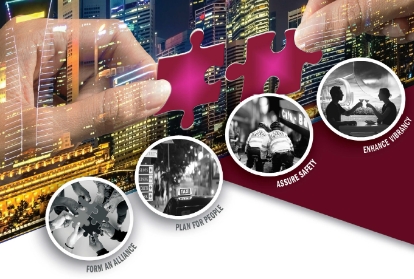Toronto Sociable City at Night: Hospitality Zone Assessment

TRANSITIONING FROM NO LONGER TO NOT YET
Toronto is a vibrant destination for dining, entertainment and nighttime social activity. From events and festivals to bars, restaurants and nightclubs, there is a plethora of options for visitors and residents. Unique voices, flavours, and forms of artistic expression have a home in the city. Diversity truly is Toronto’s strength, as the city’s motto goes.
But balancing the diversity of opinions, priorities and needs of a population as large and diverse as Toronto is no easy feat. There is renewed vigor by different sets of stakeholders to preserve what makes Toronto great in spite of current trends and circumstances.
Cranes are currently ubiquitous in the skyline. Yet with a development boom comes rising costs. Nightlife venue operators struggle to keep the doors open while continuing to provide quality entertainment. Some businesses have already been displaced or shut down. For some residents, nightlife venues were the very amenities that drew them to live in the downtown core. For the businesses still operating, arcane rules and regulations restrict entrepreneurs’ ability to innovate. Or, they are forced to convey half-truths because a checkbox doesn’t exist for their business model. Although bureaucratic processes are cumbersome and economic trends add a layer of difficulty for business operators, the demand for nighttime social spaces is highly evident. In fact, social spaces are replacing brick and mortar retailers in some areas.
The current marketplace of consumers is still hungry to shop—but for experiences, not goods. More people inside venues and out on the street at night creates traffic, safety and sound impacts. As a result of nighttime disturbances, residents have galvanized to advocate for higher standards for quality of life.
Despite some residents’ opinions, much of the city is still oriented to a daytime economy and doesn’t provide sufficient support to address nighttime needs. For example, public safety agencies are forced to do more with less—assure public safety with less than optimal staffing resources at night.
Pressure is mounting to develop a clear vision for the future of the city and create the systems to support that vision. Tough questions are being wrestled with— the answers to which may define the very heart of Toronto’s future. Will the City of Toronto take its place among other global cities to become a vibrant destination for life at night or not? Is it possible for the city to be both a high quality, safe home to urban residents and welcoming host to nighttime revelers?
A VISION IS STARTING TO COALESCE
The city has invested resources to plan for the future, which will guide policy decisions relating to the nighttime economy. There are also many signs of hope. There is a newfound recognition that nighttime activity—life at night—is a significant contributor to society, culture and the economy.
Toronto is one of three cities (with Dublin, Ireland and Cancun, Mexico) participating in a Global City Project conducted by the Responsible Hospitality Institute (RHI) to reduce harm and enhance vibrancy in the nighttime economy. This project is a partnership between RHI and Toronto Association of Business Improvement Areas (TABIA) with support from the City of Toronto’s Economic Development & Culture Division.
The suggestions outlined in this report aim to connect the disparate strategies into a comprehensive framework to support Toronto as a sustainable destination for safe and vibrant places to socialize.